Text
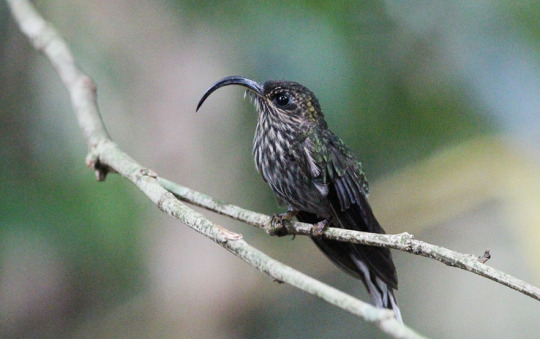
White-Tipped Sicklebill (Eutoxeres aquila)
Family: Hummingbird Family (Trochilidae)
IUCN Conservation Status: Least Concern
The distinctive elongated, downwards-curving and perhaps just slightly goofy-looking beak of this small, dull-coloured hummingbird is an adaptation that allows it to feed on the nectar of plants with curved, tube-like flowers, particularly “lobster claws” in the genus Heliconia, which in turn rely heavily on sicklebills for pollination. Found mainly in evergreen forests across southern Central America and northern South America, White-Tipped Sicklebills, like other hummingbirds but unlike the vast majority of other bird species, utilize an insect-like manner of flapping that allows them to hover and move in any direction while in flight in order to carefully position themselves in a suitable place to extend their beaks and long, flexible tongues into flowers in order to feed, with a diet of sugar-rich, easily digestible nectar being necessary to meet the immense nutritional requirements associated with the extremely rapid flapping that makes their style of flight possible. Unusually for a bird White-Tipped Sicklebills are believed to breed multiple times each year, with males gathering together during the breeding seasons, producing harsh, high-pitch calls to attract females to their location and battling for the attention of mates in mid-air in a form of synchronised competitive courtship known as lekking. After mating, female White-Tipped Sicklebills build nests out of mammal fur, plant roots and spider webs (often hanging from or near Heliconia leaves, allowing for easy access to flowers) into which they lay 1-2 tiny eggs.
--------------------------------------------------------------
Image Source: Here
#White-Tipped Sicklebill#white-tipped sicklebill#sicklebill#sicklebills#hummingbird#hummingbirds#zoology#biology#ornithology#wildlife#animal#animals#south american wildlife#central american wildlife#bird#birds
31 notes
·
View notes
Text
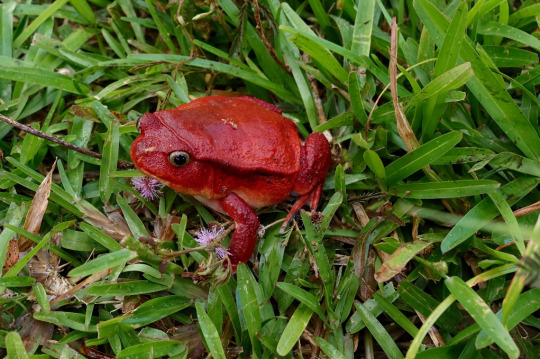
Tomato Frog (Dyscophus antongilii)
Family: Narrowmouth Frog Family (Microhylidae)
IUCN Conservation Status: Least Concern
Named for their rotund red bodies, Tomato Frogs are endemic to Madagascar where they are mostly found in wet, well-vegetated environments in the northeast. Spending the day buried beneath damp soil or leaf litter to avoid predation and dehydration, members of this species emerge at night to hunt for beetles, flies and other terrestrial arthropods, and respond to threats from nocturnal predators by inflating their bodies to appear larger and secreting a thick, sticky and mildly irritative substance from their skin, making them difficult for predators to bite or grab. Tomato Frogs breed following periods of heavy rainfall, and like almost all frogs they lay their eggs in water; males, which are smaller and paler than females, gather around suitable ponds or slow-moving rivers and streams during the night and produce low, quiet, grumbling calls, competing for the attention of females. If a female selects a male she will allow him to cling to her back and will carry him around for an extended period as she lays over 1,000 soft, transparent eggs which he fertilizes externally. Shortly after fertilization the eggs hatch into tiny, limbless, fully aquatic tadpoles that gradually develop limbs and lungs over the course of several months - after transitioning to life on land young Tomato Frogs are initially dull brown or pale yellow, gradually developing a redder colouration until they reach full maturity at 2-3 years of age.
------------------------------------------------
Image Source: Here
#tomato frog#Tomato Frog#frog#frogs#amphibian#amphibians#zoology#biology#herpetology#wildlife#African wildlife#herpetofauna
139 notes
·
View notes
Text

Acute Bladder Snail (Physella acuta)
Family: Bladder Snail Family (Physidae)
IUCN Conservation Status: Least Concern
A common resident of ponds, lakes and streams across much of Europe and North America, the Acute Bladder Snail spends the vast majority of its life underwater but can only extract oxygen from air, so must regularly climb to the surface to re-fill an air-filled bladder within its shell (earning it its name.) Hardy and fecund, members of this species feed on aquatic plants, algae and detritus and rely on their curled shells for protection against their many predators, which include numerous small fish, freshwater turtles, non-parasitic leeches and larger carnivorous snails - should a predator grasp or bite them, Acute Bladder Snails are capable of using a unique muscle to furiously waggle their shell in an attempt to shake them off before detaching from the surface they are attached to and attempting to sink to safety. Like most gastropods Acute Bladder Snails are hermaphrodites (with every individual producing both sperm and eggs) and are capable of fertilizing their own eggs, although where possible they show a preference for mating with other members of their species instead (likely because self-fertilization reduces the health and fitness of offspring due to a lack of genetic diversity.) Following mating, members of this species lay dense clusters of tiny eggs covered by protective gelatinous sacs, which they typically attach to the stems or leaves of aquatic vegetation.
---------------------------------------------------------
Image Source: Here
#Acute Bladder Snail#acute bladder snail#bladder snail#snail#snails#zoology#biology#malacology#animal#animals#wildlife#gastropod#gastropods#European Wildlife#North American Wildlife#mollusc#molluscs#mollusk#mollusks#aquatic wildlife#pond wildlife#freshwater wildlife#invertebrate#invertebrates#freshwater invertebrates
15 notes
·
View notes
Text

Walking Catfish (Clarias batrachus)
Family: Airbreathing Catfish Family (Clariidae)
IUCN Conservation Status: Least Concern
Native to the island of Jawa in Indonesia but also present as an invasive species across much of southern Asia and North America, the Walking Catfish is an adaptable species found in a wide range of freshwater habitats, but does best in stagnant, oxygen-poor pools where its ability to extract oxygen from air using a frilly, vaguely lung-like internal respiratory organ connected to its gills known as a suprabranchial organ allows it to live where most competing fish species cannot, increasing it's ability to access the aquatic plants, invertebrates and occasional small vertebrates on which it feeds. As pools inhabited by members of this species are often stagnant or small it is not unusual for them to dry up, and to account for this Walking Catfishes, as their name suggests, have developed the ability to slowly crawl across dry land using a set of tough spines on their pectoral fins, using this along with their ability to breathe air to survive out of water for up to 18 hours, allowing them to travel to new pools.
-----------------------------------------------------------
Image Source: Here
#Walking Catfish#walking catfish#fish#fishes#catfish#catfishes#zoology#biology#icthyology#animal#animals#wildlife#Asian wildlife#freshwater fishes#freshwater fish#bony fish#bony fishes
21 notes
·
View notes
Text

Spotted Thick-Knee (Burhinus capensis)
Family: Stone-Curlew Family (Burhinidae)
IUCN Conservation Status: Least Concern
Found mainly in dry grasslands and open woodlands across much of sub-Saharan Africa (although it is not uncommon for them to wander into more urban areas) the Spotted Thick-Knee is a relative of gulls, plovers, puffins and other seabirds that has adapted to terrestrial inland life, with the long legs of its wading ancestors allowing it to run at considerable speeds in pursuit of insects, small lizards and other land-dwelling prey while its speckled brown back and wings allows it to camouflage against dry vegetation to avoid detection by predators (mainly large birds-of-prey.) Most active at night, Spotted Thick-Knees spend much of the day resting with their bodies flattened against suitable vegetation to make them inconspicuous, and emerge at dusk to hunt and search for mates. The eggs of Spotted Thick-Knees, which are usually laid in pairs in twig-lined nests built under bushes or among tall vegetation, have similar markings on their shells to the feathers of adult birds to help them blend in, and both parents work together to feed and protect their chicks; if the nest is approached by a larger animal a parent will cover the eggs or chicks with their wings and fiercely peck at the potential intruder should they come closer, and in extreme situations adults have been observed pretending to be injured a short distance away from the nest in order to draw predators to them and away from their chicks.
--------------------------------------------------------
Image Source: Here
#zoology#biology#ornithology#Spotted Thick-Knee#Thick-knees#waders#bird#birds#animal#animals#wildlife#African wildlife
118 notes
·
View notes
Text
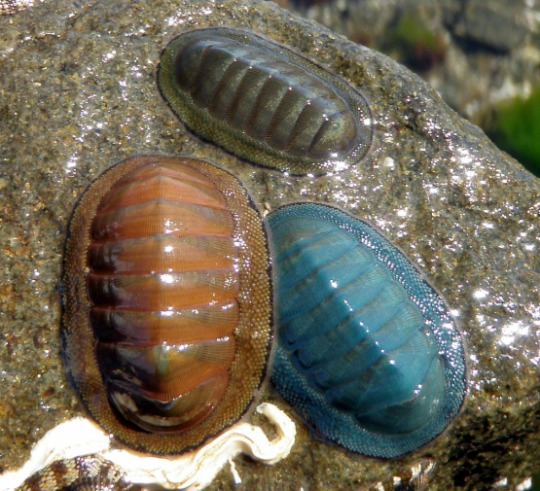
Blue-Green Chiton (Chiton glaucus)
Family: Typical Chiton Family (Chitonidae)
IUCN Conservation Status: Unassessed
Like other chitons, the Blue-Green Chiton is a heavily armoured eyeless mollusc related to marine snails which relies on its strong aragonite-based shell to defend it from potential predators as it slides slowly along on a frilly "foot", clinging to surfaces beneath it as it travels using a layer of thin-yet-sticky mucus and the suction-cup-like shape formed by the foot's frilly rim. Although they lack any conventional eyes, the 8 armoured plates of a chiton contain numerous lens-like structures (also made of aragonite) which focus light onto a retina-like membrane, allowing the chiton to perceive light and possibly basic shapes above them in order to identify potential predators, giving them an opportunity to grip more tightly onto the surface beneath them to prevent them from being flipped over to expose their unarmoured underbelly (although if this does happen they are also able to curl up in order to leave as little of their foot exposed as possible.) Found in coastal and estuarine waters surrounding New Zealand and Tasmania, Blue-Green Chitons spend much of the day concealed in rocky cracks or under large stones and emerge at night to feed, using a spiny tongue-like structure that extends from their tiny downwards-facing mouths to scrape algae off of the rocks beneath them. The name of this species refers to the variety of colours seen on the shells of different individuals; while typically dull green, individuals with blue, yellow or pale brown shells are also frequently reported.
-------------------------------------------------------
Image Source: Here
Also see here for a very cool video explaining how chiton "eyes" work.
#Chiton#chiton#chitons#zoology#biology#malacology#animal#animals#marine animals#marine wildlife#marine biology#mollusc#molluscs#mollusk#mollusks#Oceanian wildlife#Blue-Green Chiton#new zealand wildlife#australian wildlife#wildlife#nature
28 notes
·
View notes
Text

Whistling Kite (Haliastur sphenurus)
Family: Hawk Family (Accipitridae)
IUCN Conservation Status: Least Concern
A distinctively-coloured hawk found in lightly-forested areas of New Guinea, New Caledonia and Australia, the Whistling Hawk is named for its high-pitched, melodious call that sounds somewhat like whistling. Living alone or in monogamous mating pairs (though on occasion small gathering of individuals are recorded,) members of this species are strictly carnivorous but are highly adaptable generalists when selecting prey; in addition to actively hunting insects and smaller birds in the air and snatching up small mammals on the ground, members of this species living near urban areas have been reported to learn where large roads within their range are located and regularly check them for carrion, and Australian populations of Whistling Kites are one of three species referred to as "fire hawks", in reference to their habit of dropping burning sticks found near fires onto areas covered by dry vegetation in order to deliberately start wildfires that force concealed prey to flee out into the open. Paired Whistling Hawks nest in tall trees and coincide their breeding with periods in which prey is abundant in order to maximise the supply of food available for their chicks, which are typically produced in pairs and which both parents work to feed and protect. Like many hawks young Whistling Kites fledge at a relatively young age (typically between 40-50 days of hatching) but remain in their parents' territory for over a month afterwards, continuing to be fed and protected by their parents until they are large enough to leave and seek out a mate of and territory of their own - after finding a partner, members of this species typically remain together for life.
-------------------------------------------------------
Image Source: Here
#Whistling Kite#whistling kite#kite#kites#hawk#hawks#bird#birds#zoology#biology#ornithology#bird of prey#birds of prey#raptor#raptors#animal#animals#wildlife#Australian wildlife#New Caledonian wildlife#New Guinean wildlife
8 notes
·
View notes
Text

January's Fossil of the Month - Conocoryphe (Conocoryphe spp.)
Family: Conocoryhphe Family (Conocoryphidae)
Time Period: 505 Million Years Ago (Mid Cambrian)
First appearing alongside most living animal phyla during the Cambrian Explosion roughly 538 million years ago and persisting until around 251 million years ago when they were driven to extinction in the most extreme extinction event in the earth's history, the Great Dying, the Trilobites were a large, diverse and extremely successful group of marine arthropods characterised by their thick exoskeletons which were divided into three major sections known as lobes (earning them their name, which translates roughly to "three lobes.") Throughout their over 270 million years on earth trilobites diversified massively as different species adapted to exploit different habitats and ecological niches; while many early trilobites were seafloor-dwelling detritivores, later species such as Hypodicranotus striatulus, show adaptations for swimming freely, while Cruziana (known only from its fossilized footprints) seemed to plough the sediment beneath it to filter out organic material, and members of the genus Olenoides exhibit head anatomy that suggests that they may have been active predators that fed on smaller invertebrates. Compared to later oddballs such as the stalk-eyed Asaphus kowalewskii or extremely spiny Dicranurus monstrous the members of the genus Conocoryphe, an early trilobite genus found commonly in Cambrian-aged rock deposits from North Amerca and western Europe, appear generic except for one unusual characteristic; most species in this genus lack the large compound eyes of most trilobites entirely, suggesting that as bottom-dwellers with limited access to sunlight they had no need for sight and relied on alternative senses to navigate and find food. As if the loss of eyesight in such early animals wasn't unusual enough, a single later Conocoryphe species, Conocoryphe oculata, possessed grooves on its head that suggests that members of this species regained the eyes their ancestors had lost (possibly indicating that they lived in shallower, better-lit waters than their relatives.)
---------------------------------------------------
Image Source: Here
#Conocoryphe#trilobite#trilobites#zoology#biology#marine biology#paleontology#animal#animals#prehistoric animals#invertebrate#invertebrates#prehistoric invertebrates#wildlife#prehistoric wildlife#fossil#fossils#Cambrian wildlife#Cambrian fossils#nature
73 notes
·
View notes
Text

Black Heron (Egretta ardesiaca)
Family: Heron Family (Ardeidae)
Least Concern: Least Concern
A relatively small species of heron with dark grey feathers and distinctive bright yellow feet, the Black Heron is found across much of Sub-Saharan Africa (reportedly being most common in the east of the continent, including in parts of Madagascar) and is best known for its unique and extremely odd-looking method of catching prey; like other herons Black Herons are carnivorous and feed on fish, frogs and aquatic invertebrates, but instead of relying solely on their excellent eyesight and fast reflexes to catch their prey members of this species form "canopies" by spreading their wings around their bodies to form dome-like structures, luring prey into what seems like a shaded, sheltered hiding place before quickly snatching them out of the water using their long, powerful beaks. Typically found near shallow lakes or streams but also sometimes seen in coastal environments, Black Herons are often seen travelling and feeding in small groups, and generally build their nests (which are large, sturdy platform-like structures typically suspended above water to make them harder for predators to access) alongside not only other members of their species but also other species of herons, ibises and cormorants. Black Herons breed during periods of prolonged rainy weather (with the feet of males turning bright red when they are receptive to mating,) and shortly afterwards females produce clutches of 2-4 white or pale blue eggs. Each female will defend her eggs fiercely, and while members of this species will not actively defend other females' eggs nesting in groups is thought to increase every individual egg's likelihood of surviving in the event of a predator attacking, as large colonies of aggressive mother herons are likely to intimidate all but the largest of egg-eaters.
------------------------------------------------------------------
Image Source: Here
#Black Heron#black heron#bird#birds#zoology#ornithology#animal#animals#wildlife#African wildlife#Pelecaniformes#herons#heron#water birds#water bird#nature
19 notes
·
View notes
Text

Flask-Shaped Pitcher Plant (Nepenthes ampullaria)
Family: Typical Pitcher Plant Family (Nepenthaceae)
IUCN Conservation Status: Least Concern
Most species of pitcher plants are carnivorous, using jug-like, fluid-filled traps that protrude from their leaves to capture small animals and digest their bodies, absorbing the nutrients released (particularly nitrogen, which is needed to produce chlorophyll and which is scarce in the soil around them due to intense competition with other plants) across the trap's inner walls. The Flask-Shaped Pitcher Plant, however, is unusual among its relatives in that it is seemingly essentially a herbivorous plant - found in damp, dense forests, it grows as a woody vine that creeps along the ground or through the lower branches of larger plants and uses its unusually short, wide pitchers to catch leaves that fall down from the trees above it, digesting them to make use of the nitrogen and other nutrients they contain. Widely distributed across much of Brunai, Indonesia, New Guinea, Malaysia, Thailand and Singapore and reportedly quite common in damp, humid environments throughout their range, members of this species are dioecious (meaning that each individual plant is either "male", producing pollen-producing flowers, or "female", producing pollen-receiving flowers that develop into seeds once pollinated,) and produce dense clusters of small, petal-less flowers relatively high in their "branches", typically far from their traps to avoid accidentally trapping pollinators. Once pollination has occurred, "female" flowers produce numerous tiny, lightweight, hair-like seeds which are carried away from their "mother" on the wind.
----------------------------------------
Image Source: Here
#Flask-shaped pitcher plant#pitcher plant#pitcher plants#nepenthes#carnivorous plant#carnivorous plants#botany#biology#wildlife#plant#plants#Asian wildlife#Nepenthes
94 notes
·
View notes
Text

Jungle Cat (Felis chaus)
Family: Cat Family (Felidae)
IUCN Conservation Status: Least Concern
Despite what its name suggests the Jungle Cat is not typically found in jungles, instead being a resident of densely vegetated swampy areas of northeastern Africa and western, southern and southeastern Asia. Like most wild cats members of this species are solitary, territorial (marking the outer limits of their territories with strong-smelling urine and saliva) and primarily active at night but not strictly nocturnal, waking up sporadically throughout the day to search for food (feeding primarily on small vertebrates such as rodents, lizards, fishes and frogs, though on occasion they may also consume fruit or target prey as large as Wild Boars and young Chitals (a medium-sized species of deer.)) Jungle Cats come together only to breed (producing high-pitch calls and sniffing the scent markings of other members of their species when receptive to mating,) and while females provide for their litters of 3-6 kittens largely on their own, males have been reported to remain nearby to defend their young for a short period after birth. Newborn Jungle Cats are larger and more developed at birth than many other cat species, being capable of hunting for themselves at around 6 months old and being fully independent by the time they are 9 months old.
------------------------------------------------------------
Image Source: here
#Jungle Cat#jungle cat#cat#cats#wild cats#wild cat#wildcat#zoology#biology#mammalogy#wildlife#African wildlife#Asian wildlife#carnivores#carnivorans#animal#animals#mammal#mammals
18 notes
·
View notes
Text

Lion's Mane Jellyfish (Cyanea capillata)
Family: Cyaneid Jellyfish Family (Cyaneidae)
IUCN Conservation Status: Unassessed
Named for its frilly "mane" made up of over 1,200 long, stinging tentacles, the Lion's Mane Jellyfish is among the largest known jellyfish species; while this viral image showing a diver next to a Lion's Mane Jellyfish has been edited to make the jellyfish appear far larger than it actually is, members of this species still dwarf most of their relatives, with a bell ("main body") diameter of over 2.4 meters (7.89 feet) and a tentacle length of as much as 30 meters (98.4 feet), making it one the longest animals on earth. Typically found near the surface in the Arctic, northern Atlantic and northern Pacific Ocean regions, Lion's Mane Jellyfishes, like all jellyfishes, lack brains, eyes, hearts or respiratory organs (instead exchanging gasses directly between the water around them and their extremely thin tissues,) and rely heavily on waves and ocean tides to travel, but are able to slowly propel themselves in a given direction by expanding the 8 bag-like lobes of their bodies to take in water and then forcing it out again to push themselves along (although they can also to some extent detect and react to their orientation and surroundings owing to a series of frilly sensory structures located around their body's rim, know as rhopalia.) Like most jellyfishes the long, trailing tentacles of a Lion's Mane Jellyfish are lined with touch-sensitive, harpoon-like cells called cnidocytes that fire venomous barbs into any animal that touches them, and after a tentacle has stung and ensnared suitable prey (mainly fish, large plankton and smaller jellyfishes) it is pulled back towards the body where the prey is passed through a mouth-like opening on the jellyfish's underside and into a simple body cavity where it is digested, with any indigestible matter, such as shells or bones, later being ejected from the body through the same opening it entered through. The life cycle of the Lion's Mane Jellyfish, like that of most jellyfishes, takes place in 4 distinct stages and seems highly elaborate compared to that of most animals; the bag-like adults that we typically think of as jellyfishes, known as medusas, are either male or female and reproduce sexually by releasing gametes into the water around them, and should these gametes meet they fuse and develop into tiny larvae. The larvae then settle onto a solid surface and develop into polyps (a second, immobile life stage resembling a sea anemone,) and each polyp then asexually reproduces several times, with genetically identical, slow-swimming young splitting off of its body as buds. Each of these asexually-produced individuals will then develop into a medusa, continuing the cycle and meaning that each single instance of sexual reproduction in Lion's Mane Jellyfishes produces multiple asexually-produced offspring. Despite their massive size medusas of this species only live for around a year, although their polyps, which only reproduce under ideal environmental conditions, may remain dormant for longer than this.
---------------------------------------------
Image Source: here
#Lion's Mane Jellyfish#jellyfish#jellyfishes#cnidarians#cnidarian#cnidology#animal#animals#zoology#invertebrate#invertebrates#marine biology#marine invertebrates#scyphozoa#wildlife#marine wildlife
158 notes
·
View notes
Text

Naval Shipworm (Teredo navalis)
Family: Shipworm Family (Teredinidae)
IUCN Conservation Status: Unassessed
Despite what their name and worm-like bodies suggest, shipworms like the Naval Shipworm are actually small clams adapted to burrowing; their shells, made up of two halves called valves, are located on the front of their body and act like powerful jaws used to bore into surfaces (although there is no mouth behind these "jaws",) while their siphons (a pair of muscular tube-like structures that take food and water to the gills and release waste and gametes into the water, and which are protected by the shell in most other clam species,) are located on the opposite end of their body (labelled d and e in the image above.) Like most shipworms, the Naval Shipworm builds its burrows in submerged wood such as driftwood, and is particularly infamous for its habit of boring into hulls of wooden ship, threatening the ship's structural stability and allowing the species to spread to as the ships travel - today members of this species can be found in non-polar seas and estuaries worldwide, leaving it unclear where exactly they originate from. After settling in a piece of wood young Naval Shipworms construct a strong inner casing around themselves using mucus and calcium carbonate filtered from the water around them, and if left to their own devices they will remain in their burrows for the rest of their lives with only their siphons exposed, gaining nutrients from algae and wood shaving taken in through their inhalant ("intake") siphons (with their gills both filtering algae from inhaled water and housing mutualistic bacteria that secrete enzymes capable of digesting wood, which the shipworm could not do on its own) and periodically releasing dung, gametes or larvae from their exhalent ("outgoing") siphon. All Naval Shipworms are born as males, but some individuals develop into females as they get older - mature females take in gametes released by males to fertilize their eggs internally, and after hatching the larvae remain in their mother's gills where they are protected and given access to the nutrients she takes in until they are old enough to be released into the water, after which they (now known as "veligers") undergo further development as free-swimming, algae eating plankton before settling on a suitable piece of wood and developing into adults.
------------------------------------------------------
Image Source: https://www.inaturalist.org/taxa/209057-Teredo-navalis
Cool diagram of a Naval Shipworm burrow, plus some more information: https://animaldiversity.org/accounts/Teredo_navalis/pictures/collections/contributors/Grzimek_inverts/Bivalvia/Teredo_navalis/
#Naval Shipworm#naval shipworm#shipworm#shipworms#molluscs#mollusks#mollusc#mollusk#zoology#biology#malacology#bivalve#bivalves#animal#animals#wildlife#marine wildlife#marine biology
9 notes
·
View notes
Text
COOL ZOOLOGY STORIES OF 2023
Happy New Year! At the start of 2022 I put together a list of some cool zoology-related news stories from 2021, and after... kind of forgetting to put a list together for 2022, I wanted to do the same for 2023. Here are some of my favourite animal-related news stories from the past year (plus one plant-related story, as a treat.)
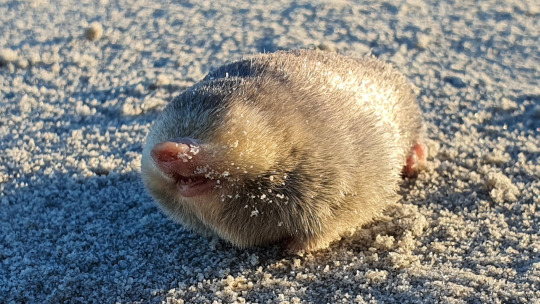
An elusive little mammal was spotted for the first time in nearly a century
Species Concerned: De Winton's Golden Mole (Cryptochloris wintoni)
Family: Golden Mole Family (Chrysochloridae)
Source(s): here and here
A small, superficially mole-like animal seemingly found only in the area around Port Nolloth, South Africa, De Winton’s Golden Mole has long been feared to be extinct due to a total lack of confirmed sightings since 1937. This changed in November of 2023, when (after years of extensive searching) a De Winton’s Golden Mole was found alive for the first time in 87 years, and was photographed for the first time ever.
Though similar to moles in both appearance and behaviour, golden moles are actually part of a separate and only distantly related group of mammals known as Afrosoricidans (alongside tenrecs and otter shrews) that have independently developed mole-like bodies to exploit a similar ecological niche – with massive, shovel-like front paws, short limbs, protective “shields” of toughened skin on their heads and non-functional eyes covered by skin to protect them from irritation, members of this family are adapted to burrowing, and in most cases will spend their entire lives underground unless disturbed. Due to the scarcity of sightings very little is known about the biology of De Winton’s Golden Mole, but based on its sandy coastal habitat and the behaviours of its closest relative, the Van Zyl’s Golden Mole (Cryptochloris zyli) it is likely that members of this species live solitary lives and use their digging abilities to “swim” through sand, preying on insects and small vertebrates which they detect using unique structures in their inner ears that are highly sensitive to vibration.
In addition to conventional habitat surveys within De Winton’s Golden Mole’s presumed range, the team responsible for this species’ rediscovery also utilized several newer or more unusual strategies to search for their focal missing mammal, including thermal imaging to detect underground body heat and the testing of soil and sand in the area for eDNA (tiny amounts of genetic material that organisms leave in water, soil and on other surfaces, giving insight into which species are found in an area without having to actually spot them.)
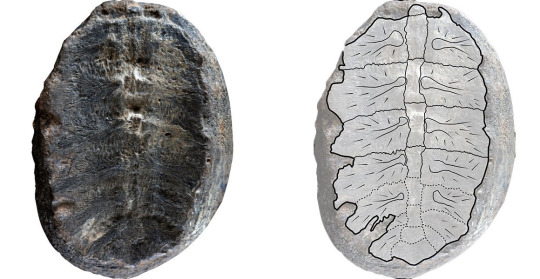
An "ancient plant" turned out to be a baby turtle
Species Concerned: "Turtwig" Cretaceous Turtle
Family: Unknown
Source(s): Here and Here
In 2003, a priest and fossil collector named Gustavo Huertas identified what he believed to be the fossilised remains of a tiny plant of the extinct genus Sphenophyllum in cretaceous-era rocks near Villa de Leyva, Columbia, and named the new species Sphenophyllum colombianum. Huertas' find was unusual in that it dated to the early Cretaceous period (making it over 100 million years younger than other Sphenophyllum species, the last of which are believed to have gone extinct in the late Triassic period,) and it was the fossil's unusual age that drew the attention of Fabiany Herrera, a curator of plant fossils at the Field Museum of Natural History in Chicago, USA and Héctor Palma-Castro, his student. After taking an interest in the fossil the two travelled to the Universidad Nacional de Colombia in Bogotá, Columbia where the fossil was held in order to inspect it, and after realising that its features were unlike other Sphenophyllum species and consulting a vertebrate palaeontologist, Edwin-Alberto Cadena, they eventually came to realise that what Huertas had found was not a Sphenophyllum species, or event a plant - what had originally been interpreted as the stems and leaves of a plant were actually the ribs of a very small, and likely very young, prehistoric turtle.
The ribs of turtles are located on the upper surface of their shells, where they form a sort of "roof" that strengthens the shell's outer carapace. Newly hatched turtles have fragile bones and shells that are easily broken beyond recognition during fossilization, so finding the well-preserved remains of a young turtle (estimated to be less than 1 year old when its bones were buried) is very rare. The discovery of the true identity of "Sphenophyllum colombianum" was published (here) in early December 2023, and as such the newly discovered turtle fossil has yet to be given a new name. Instead, it has been affectionately dubbed "Turtwig", after the half-plant-half-turtle gen 4 starter Pokemon, until it can be formally reclassified.
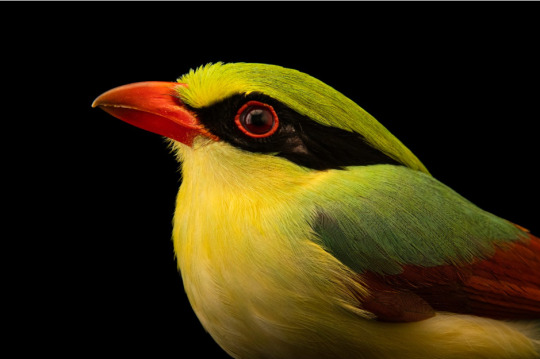
The Indochinese Green Magpie became the Photo Ark's 14,000th species
Species Concerned: Indochinese Green Magpie (Cissa hypoleuca)
Family: Crow Family (Corvidae)
Source: Here
The National Geographic Photo Ark is an ambitious project led by Canadian photographer Joel Sartore which aims to photograph every species held in captivity worldwide, providing high-quality images of often relatively obscure species and raising awareness of each species involved. In 2021 the Arabian Cobra became the 12,000th species added to the ark, in 2022 the Spoon-Billed Sandpiper became the 13,000th, and as of May 2023 the Indochinese Green Magpie has become the 14,000th species Sartore and his team have photographed.
Unlike the vast majority of crow species, the 4 species in the genus Cissa, known collectively as green magpies, are brightly coloured, largely carnivorous birds with vivid green feathers and bright red beaks and feet which are thought to aid them in camouflaging against the leaves and bark of the dense, humid forests they typically inhabit. The Indochinese Green Magpie, which is found in densely forested areas from central China to southern Cambodia, is one of the most common green magpie species, but is still believed to be experiencing a decline in population size due to the intense demand for members of this species in the illegal wildlife trade, both for their feathers and to be kept as illegal pets. The model for Sartore's photo, a female named Jolie, was herself found in a suitcase that was intercepted while being smuggled through the Los Angeles International Airport, and is now kept Los Angeles Zoo and Botanical Gardens. The team behind the Photo Ark have expressed hopes that Jolie's picture and story will help to raise awareness of the harmful effects of the illegal exotic pet trade and its prominence within the USA. On a happier note, the photo also seems to show that Jolie is now doing well - green magpies kept in captivity have been known to sometimes take on a duller colouration due to a lack of carotenoids in their diet, so her natural green feathers are an indicator of good health.

A very rare, very weird plant was rediscovered after 30 years
Species Concerned: Thismia kobensis
Family: Burmannia Family (Burmanniaceae)
Source(s): Here, here and here
In 1992, a bizarre-looking plant was found growing near the city of Kobe in Japan; pale and partially transparent without any leaves or chlorophyll, it was a member of the genus Thismia and was notable for being found further north than any other Asian species in the genus to date. A single plant was collected and taken to the Museum of Nature and Human Activities in the nearby city of Sanda, and in 2018 extensive examination of this single preserved plant led to it being determined to be a previously undocumented species, Thismia kobensis. This discovery led to surveys being dispatched to the area where the species was originally discovered in hopes of gathering additional samples and learning more about T. kobensis in the wild, but after surveys of the area were unable to find any remaining individuals, and following the discovery that the site from which the original sample had been collected had been converted into an industrial complex since the 1990s, the species was feared to have gone extinct. In February of 2023, a team of researchers led by Kobe University's Professor Kenji Suetsugu announced the first documented sighting of Thismia kobensis in 31 years, having found a small population growing in Sanda, not far from the museum that holds what had long been the only known specimen of the species and roughly 30km (18.6 miles) from the site at which the species was originally discovered. Their publication can be read here.
Thismia species, also known as fairy lanterns, are almost alien-looking plants that, as mentioned previously, lack chlorophyll and do not carry out photosynthesis, instead gaining nutrients parasitically by connecting their roots to the hyphae of typically mutualistic fungi and extracting nutrients from both the fungus itself and from any other plants that it has connected to (making it a mycoheteroph, much like the slightly better-known ghost plant/ghost pipes.) This unusual lifestyle likely developed as an adaptation to allow members of this genus to survive in forests with dense canopies that block out sunlight, but also makes them highly sensitive to environmental change - in order for an area to support a healthy population of Thismia kobensis, it must also support healthy trees and healthy soil fungi. As the original preserved 1992 specimen of T. kobensis was long dead and slightly damaged, its rediscovery also allowed Suetsugu's team to further study the species, leading to a surprising conclusion - genetically and anatomically, Thismia kobensis seems to have more in common with Thismia americana (the only known North American species of Thismia, which was last sighted in 1916 and is similarly feared extinct) than to any other Asian Thismia, possibly suggesting that T. kobensis and T. americana are descended from common ancestors that spread either from Asia to the Americas or vice versa during a time when their ranges were connected by a land bridge.
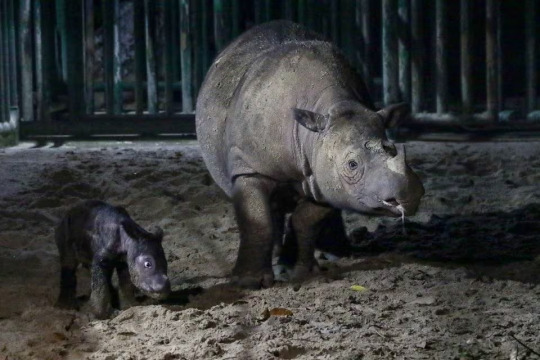
Important progress was made in saving the Sumatran Rhinoceros
Species Concerned: Sumatran Rhinoceros (Dicerorhinus sumatrensis)
Family: Rhinoceros Family (Rhinocerotidae)
Sources: Here and here
Distinguished from the other 4 rhinoceros species by its relatively small size, 2 horns and short black fur (which is barely present in adults, but very prominent in calves) the Sumatran Rhinoceros is one of the rarest mammals on earth, with an estimated population size of roughly 30-80 individuals. Having had its numbers drastically reduced by poaching, habitat loss and extreme weather events, the species is now threatened by its own small population size - found only in tiny scattered populations across Sumatra and Borneo, it is now extremely difficult for wild members of this species to find mates, and where mating does occur such a small population size considerably limits genetic diversity, increasing the risk of calves being born with health complications. To combat this numerous efforts to breed Sumatran Rhinoceroses in captivity have been developed, and as of November of 2023 the results have been promising; last year saw the birth of 2 Sumatran Rhinoceros calves at the Way Kambas National Park in Lampung, Sumatra.
The youngest of 2023's calves, a male, is the son of a female named Delilah who was herself the second calf to have ever been born at the park's Sumatran Rhinoceros Sanctuary (a site where members of this species are cared for and protected from illegal poaching while breeding.) This marks the first-ever instance of a captive-born Sumatran Rhinoceros giving birth, and therefore represents a key step in establishing a healthy captive breeding population of Sumatran Rhinoceroses to help preserve and increase the genetic diversity of wild populations. The calf's father, named Harapan, was born in Cincinnati Zoo in the USA, and it is hoped that the careful incorporation of the handful of Sumatran Rhinoceroses held in zoos into wild breeding programs can further help to increase the species' genetic diversity in the future. While extensive action is still needed for the Sumatran Rhinoceros to be saved, the park's work this year represents a significant step towards the species' conservation.
--------------------------------------------
Have a great new year!
#Happy new year!#2023#2024#zoology#biology#mammalogy#paleontology#botany#ornithology#conservation#animal#animals#plant#plants#wildlife#turtwig#de winton's golden mole#golden mole#golden moles#Indochinese green magpie#green magpie#green magpies#Thismia kobensis#Thismia#Sumatran rhinoceros#rhinoceros#rhinoceroses
33 notes
·
View notes
Text

Kit Fox (Vulpes macrotis)
Family: Dog Family (Canidae)
IUCN Conservation Status: Least Concern
A small species of fox native to warm, arid regions of northern Mexico and the southwestern USA, the Kit Fox has independently developed many characteristics also seen in its more famous desert-dwelling relative, the Fennec Fox; its body is small and slender to reduce heat retention, its ears are large and flattened (though not as disproportionally massive as the ears of Fennec Foxes) to increase heat loss through its extremities, and its feet are wide to help distribute its weight while walking on uneven sandy ground, with a light covering of fur on its paw pads to prevent them from being burned when exposed to hot rocks or sand. Like many desert-dwelling mammals Kit Foxes spend much of the day underground (either in burrows of their own creation or in the abandoned burrows of other animals such as American Badgers) and emerge at night (or occasionally early on cool mornings) to search for food, feeding primarily on small rodents but also targeting hares, lizards, insects, carrion and small amounts of fruit. Adult Kit Foxes generally live in pairs, mating once a year and working together to protect and provide for their young, which are born in litters of 4-5 and remain in or near their parents' burrow for much of their early lives, accompanying their parents on foraging trips once around 4 months old and becoming independent 1-2 months later.
--------------------------------------------------------------------------Image Source: https://www.inaturalist.org/taxa/42070-Vulpes-macrotis
#Kit Fox#kit fox#zoology#biology#mammalogy#animal#animals#mammal#mammals#fox#foxes#dog#dogs#canid#canids#canidae#carnivores#carnivore#carnivora#wildlife#North American wildlife#desert wildlife
29 notes
·
View notes
Text

European Mistletoe (Viscum album)
Family: Santalaceae (Sandalwood Family)
IUCN Conservation Status: Least Concern
Native to western and southwestern Asia as well as almost all of Europe, European Mistletoe is a hemiparasite, meaning that in addition to producing nutrients independently through photosynthesis it also meets part of its nutritional needs parasticially, growing attached to the branches of trees and forcing its roots into the internal vessels of its hosts to steal nutrients and water. After settling and maturing on a host tree, members of this species produce tiny pale-yellow flowers between February and April (with each individual plant producing either pollen-producing "male" flowers or seeds-producing "female" flowers,) and after being pollinated by small insects "female" flowers develop into round, typically white berries (although a small number of individuals instead produce yellow berries.) Unlike many plants within its range, European Mistletoe bears fruit during the winter (possibly as an adaptation to avoid having to compete with fruit-bearing host trees) and as such while the berries of this species are poisonous to most mammals many birds rely heavily on them as a winter food source, carrying the seeds within them away from their "mother" to allow them to spread to new trees. Each berry contains a single seed surrounded by an extremely sticky pulp, and after being swallowed and eventually excreted in a bird's droppings this pulp allows the seeds to adhere to branches, where they will eventually germinate, force their way into the nutrients-filled internal vessels of their host and begin their development into adulthood.
--------------------------------------------------------------------------
Image Source: https://www.inaturalist.org/taxa/57512-Viscum-album
#European Mistletoe#mistletoe#plant#plants#botany#biology#wildlife#Asian wildlife#European wildlife#parasitic plant#parasitic plants#hemiparasite#hemiparasites#christmas#flowering plant#flowering plants#angiosperm#angiosperms
6 notes
·
View notes
Text

Candy Cane Snail (Liguus virgineus)
Family: Orthalicid Snail Family (Orthalicidae)
IUCN Conservation Status: Near Threatened
Found only on the island of Hispaniola, the Candy Cane Snail is a small species of tree-dwelling, air-breathing snail named for its colourful and highly elaborate shell, which typically spirals to the right of the snail's body and is covered in distinct coloured bands (which may be yellow, white, orange, green, red or black, and are essentially "painted" onto the developing shells of young individuals as their shells are produced by colour-secreting glands on the muscular structure called the mantle at the shell's base.) While the colouration and structure of this species' distinctive shell is well-documented, very little information on its biology is available; reportedly, Candy Cane Snails feed almost exclusively on lichens that they scrape off of the branches of trees they inhabit using a spiny tongue-like structure called a radula (although they may also feed on bark) and descend to the ground during periods of wet weather to lay eggs beneath loose, damp soil. Like many land snails Candy Candy Snails must keep their soft, fragile bodies damp to remain healthy, and when faced with prolonged periods of dry weather they enter a dormant state, retreating into their shells and secreting a stretchy membrane of mucus, known as an epiphragm, around the shell's opening to minimalize water loss through evaporation.
--------------------------------------------------------------------------
Happy Holidays!
Image Source: https://www.inaturalist.org/taxa/335470-Liguus-virgineus
Note: Almost all of the information I could find about Candy Cane Snails online came from the species' Wikipedia page, and quite a few of the claims on said page didn't cite any source, so it seems wise to take the information it provided with a pinch of salt. If you're looking for some festive gastropod reading, the handful of non-wikipedia sources I could find can be seen here, here and here.
#Candy Cane Snail#snail#snails#gastropod#gastropods#mollusc#molluscs#mollusk#mollusks#zoology#biology#malacology#animal#animals#wildlife#North American wildlife#invertebrate#invertebrates#Happy holidays!
19 notes
·
View notes